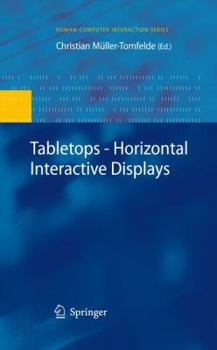Tabletops--Horizontal Interactive Displays
Select Format
Select Condition 
Book Overview
The objects displayed on a table can take multiple forms. In meetings, it is still very often printed paper although its content was originally created on a computer. The content can also be a "table", but now in the mathematical sense, showing, e. g., the budget of a project. Then, we have a "table" on the table. Most often, the computer-generated contents are subject of frequent changes or dynamic in nature. It is a logical consequence to avoid the detour and the inherent media break by transforming the surface of the table into a display able to show media that are active and can be computer-generated and computer-controlled. At the same time, it is desirable to maintain the inherent features and affordances of working with the objects and the contents while sitting or standing around a table. Electronic Meeting Rooms On the basis of these and other elaborate considerations, we started to design in 1992/1993 an electronic meeting room in Darmstadt at GMD-IPSI (later Fraunhofer IPSI). The setup of our custom-built DOLPHIN-System consisted of a "traditional" large rectangular wooden table with four physically integrated workstation-like computers with at screens. This set-up was complemented by linking a large ver- cal pen-operated interactive display, at that time the rst LiveBoard outside of Xerox PARC (two of which I was able to get to Darmstadt after my stay at Xerox PARC in 1990).
Format:Hardcover
Language:English
ISBN:1849961123
ISBN13:9781849961127
Release Date:May 2010
Publisher:Springer
Length:458 Pages
Weight:1.75 lbs.
Dimensions:1.2" x 6.3" x 9.2"
Customer Reviews
0 rating





